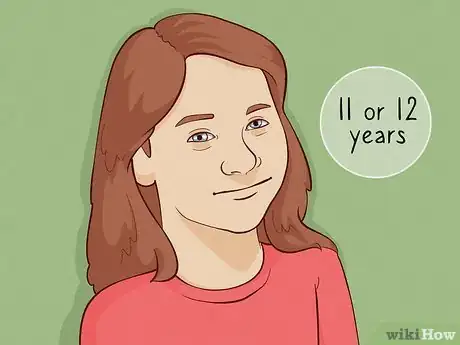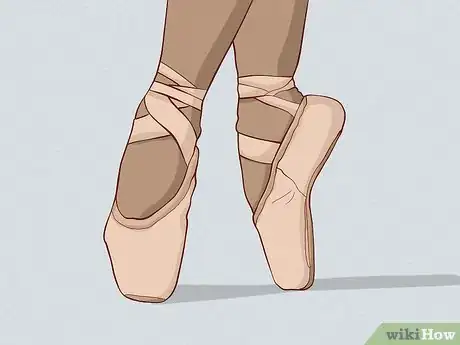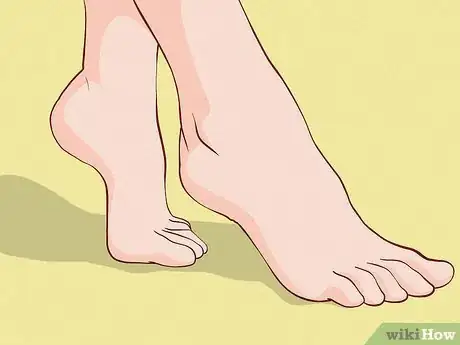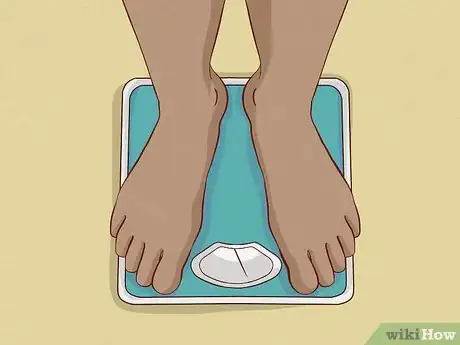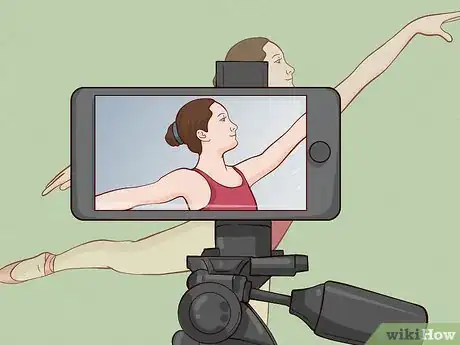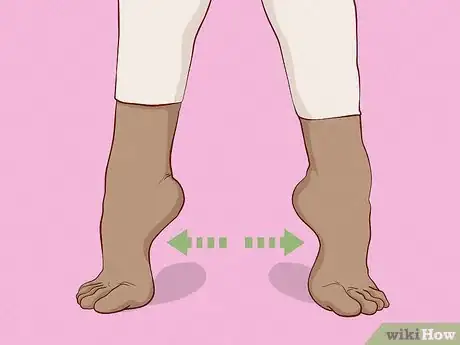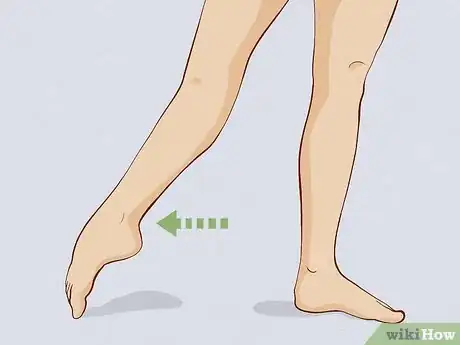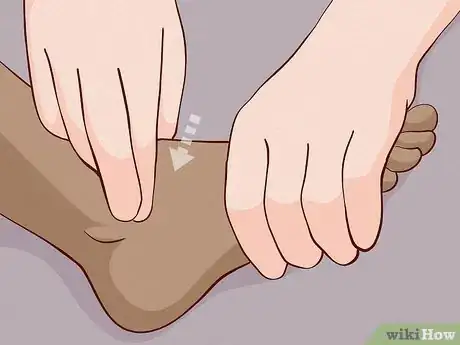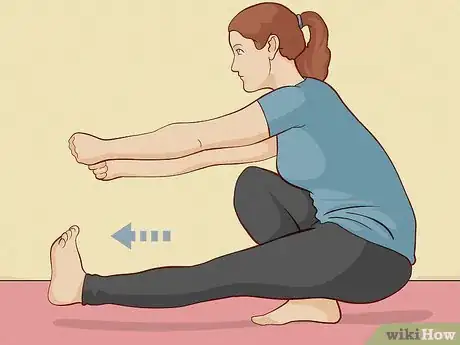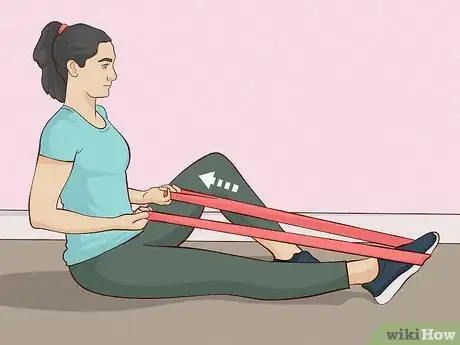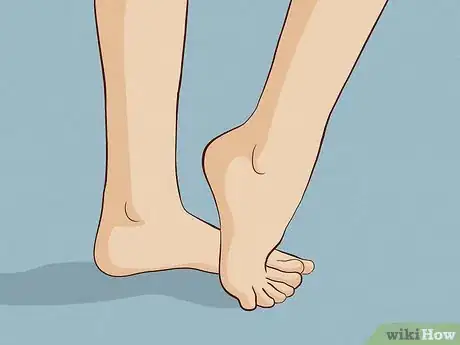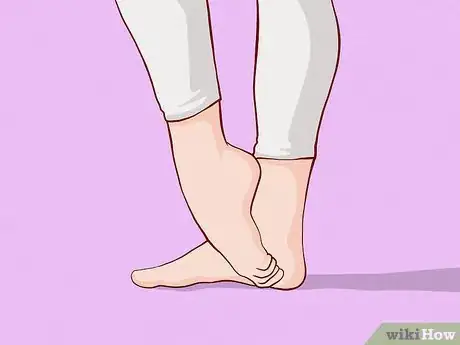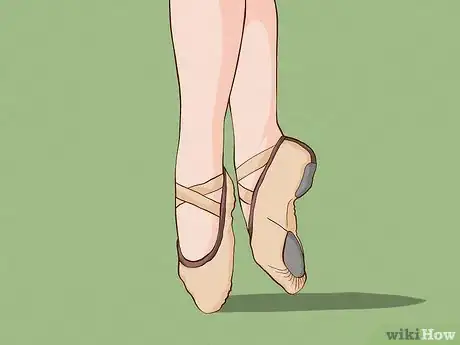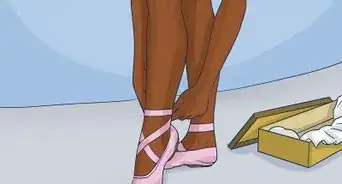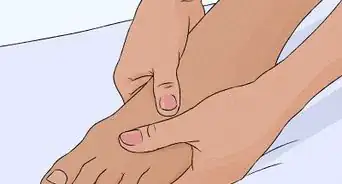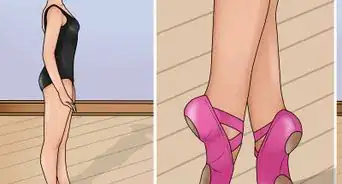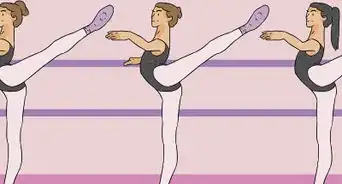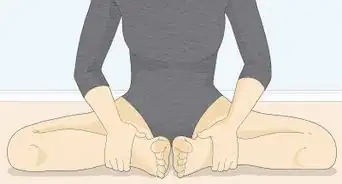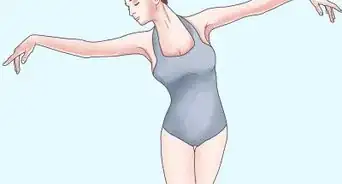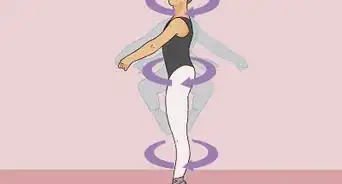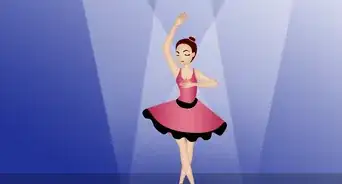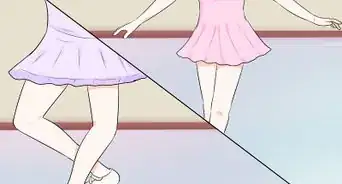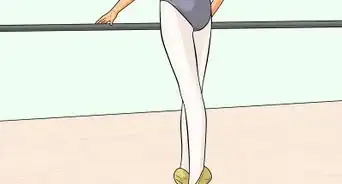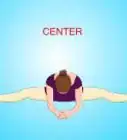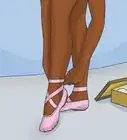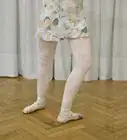This article was co-authored by Geraldine Grace Johns. Geraldine Grace Johns is a Professional Ballerina and the Owner of Grace Ballet in New York and Los Angeles. Geraldine toured through New Zealand, Australia, Japan, and Korea as Jammes in Ken Hill's Original Phantom of the Opera. She has studied with the Royal Academy of Dance in London to become a teacher and taught for the Kudo School of Ballet in Yokohama. Geraldine also ran her own Royal Academy of Dance School in New Zealand before studying at the Neighborhood Playhouse School of the Theatre in New York City. Geraldine was a guest coach and Master Class teacher in Toronto for the Canadian Royal Academy of Dance's Dance Challenge in 2018, 2019, and 2020. She was also a guest coach and Master Class teacher for the USA Royal Academy of Dance Challenge in Long Beach, California in 2019 and 2020. Grace Ballet Los Angeles has won recognition as one of 13 Best Ballet Schools in Los Angeles since opening her school. Geraldine is a contract Practical Teaching Supervisor for the Certificate in Ballet Teaching Studies for the Royal Academy of Dance.
There are 12 references cited in this article, which can be found at the bottom of the page.
wikiHow marks an article as reader-approved once it receives enough positive feedback. This article received 19 testimonials and 85% of readers who voted found it helpful, earning it our reader-approved status.
This article has been viewed 269,917 times.
Ballet is a rigorous style of dance that makes great demands of your body. Going en pointe is a big step, and a landmark moment in a young ballerina's career. Dancing en pointe can be very dangerous if the dancer is not strong enough or trained enough to do it, so don't attempt to dance en pointe unless your instructor tells you are ready. However, this article will give you a sense of how close you are to being ready to dance en pointe.
Steps
Making Sure Your Body Is Ready
-
1Make sure you’re old enough. Experts argue that it’s unsafe to begin dancing in pointe shoes before 11 or 12 years of age, because the bones in the foot are still hardening when you’re young. Dancing en pointe at a young age, before your bones are strong enough to support your weight, could result in permanent injury to your feet.[1]
-
2Take at least two years of prior ballet instructions.[2] Though some students may be asked to wait longer, especially if they are not old enough, nobody should be considered for work on pointe until they have received, at minimum, two years of instruction in the fundamentals of ballet.
- This doesn’t mean that you took one ballet class a month for two years, and are now ready to go on pointe. You need regular, rigorous training to prepare for pointe shoes.
- You should have consistently received at least 3-5 hours of training per week for the two years of prior instruction.
Advertisement -
3Check the bone structure of your foot. Unfortunately some people will never be able to dance en pointe, no matter how hard they train, simply because the bone structure of their foot would result in injury if pointe were to be attempted. The ideal foot for dancing en pointe will have the following characteristics:
- Toes should be about the same length, to provide a “squared-off” platform for stability. The most difficult foot shape is one in which the second toe is longest.
- Ankle flexibility
- High arch on the instep of the foot
-
4Make sure you are at a healthy weight. Because all of your body weight is distributed across your toes when you dance en pointe, instructors might hesitate to recommend you for pointe work if they worry your toes will not be able to handle the amount of weight you will be asking them to support.[3] Calculate your Body Mass Index (BMI) to make sure you fall within a healthy weight category before attempting pointe.[4]
-
5Check if you have a strong, straight core and upright pelvis when dancing. Have a teacher or parent evaluate you, or take a video recording of yourself dancing. It will be difficult to evaluate yourself in a mirror because craning your neck to watch your reflection might have a negative impact on your posture.
- Your back muscles and lower abdominal muscles should be engaged in holding the trunk of your body straight.
- You shouldn’t sink down into your pelvis or hip bone when placing weight on one leg.
-
6See if you can do 16 relevés in a row in demi-pointe.[5] Demi-pointe, also known as half-pointe, is when you balance on the balls of your foot rather than the toes of your foot.[6] If you cannot perform 16 relevés in a row on demi-pointe from center, your muscles are not yet strong enough to go en pointe.
- Stand at a bar or other flat surface (like a table) to support yourself if you lose your balance.[7]
- The releve can be performed from any position, first through fifth.[8]
- Roll up onto the balls of your feet and hold that position for a few seconds.
- Keep your weight centered over first three toes. Don't let your weight shift so you're balancing on your little toes.
- Don't "release your turnout" by letting your heels turn backwards. Engage your rotators and abdominal muscles to keep your heels pointed inward so your toes and knees point outward.
- Roll back down until you're flat-footed.
- Repeat 16 times.
-
7Be able to maintain correct turnout while dancing on flat foot or demi-pointe.[9] If you can’t maintain correct turnout normally, you will have a lot of trouble maintaining it en pointe, because it’s more difficult to maintain turnout then. Your foot should stay in line with your kneecap and hip joint, with your ball of your big toe acting as the balancing pointe for your body weight. You should maintain straight knees and keep your heels forward to avoid sickling.[10]
-
8Ask your teacher to assess your foot and ankle strength. Even if you think you're ready, it's really up to your instructor to decide if you're strong enough to go on pointe—you can damage your feet if you do it to early.[11] Either the instructor or a physical therapist recommended by your instructor will know what to look for in evaluating your body. If you think you meet the other benchmarks and are ready to begin pointe work, ask your instructor for an evaluation.
- If your instructor thinks you're ready to go on pointe, they'll take you to get fitted for your first pair of pointe shoes.[12]
Building Strength and Technique
-
1Build ankle strength.[13] There are many exercises you can do outside of ballet steps that will build up ankle strength to ensure you’re performing technical steps safely.
- Play balance and catch: standing on one leg, throw a ball back and forth with a partner. The heavier the ball, the better the workout will be for your ankle. Have your partner throw it all around your center — above you, to your right and left, etc. — to further force your balance to shift.
- One-legged squats: Extend one leg in front of you, then do ten half squats. Swing the leg out to the side and do 10 more half squats. Swing the leg behind you, and do ten more half squats. (Adjust reps up or down based on comfort level.)
-
2Exercise with a Theraband. A Theraband is an elastic resistance band that can be used for both strength and flexibility training.[14] With the following exercise, do not do it because of the research of new scientists showing that it harms your toes with the resistance both forwards and backwards. Instead, try doing the same thing but with a small ball, or a yoga ball.
- Sit straight-backed on the floor with legs extended in front of you.
- Loop the Theraband around the ball of your foot and pull backward to create tension.
- In a slow, controlled motion, point and flex your toes, making sure your feet do not sickle.
-
3Practice metatarsal doming.[15] Metatarsal doming exercises strengthen the small, intrinsic muscles in the foot that you don’t think about on a day-to-day basis, but which are very important for proper technique.
- In a standing position, tighten your toes to provide a stable base for your foot.
- Pull your foot back, arching your instep as far as possible.
- Hold this position for a count of six seconds, then relax for ten seconds.
- Perform ten reps of this exercise on each foot.
-
4Practice going on demi-pointe. Although it’s safer than dancing en pointe, it’s actually more difficult to hold positions in demi-pointe. Practice dancing on demi-pointe to strengthen the muscle groups you’ll need to dance en pointe and work on your balance.
-
5Practice steps and exercises that will prepare you for pointe. Instructors will expect you to perform a specific set of steps when they make their decision about whether or not you are ready to graduate to pointe. Although you should ask your specific instructor what he or she will be looking for, in general, instructors are looking for the following abilities, which you should practice:
- Hold a passé balance, in which you pull one leg up and tuck the ball of your foot into your knee, while standing on half-pointe for as long as you can.
- Maintain perfect form during pliés, in which you bend your knees while maintaining your turnout, so your feet are pointed outward.
- Pointe your feet when dancing; pointing when dancing on demi-pointe strengthens the muscles you will need en pointe.
- Perform a piqué passé with straight leg: standing on one leg in demi-pointe, bring the other leg up into a passé balance, then bring it down to touch the ground, before bringing it back up into a passé balance.
- Do 16 relevés in the center in a row.
Expert Q&A
Did you know you can get expert answers for this article?
Unlock expert answers by supporting wikiHow
-
QuestionHow do I know when I'm strong enough to go on pointe?
 Geraldine Grace JohnsGeraldine Grace Johns is a Professional Ballerina and the Owner of Grace Ballet in New York and Los Angeles. Geraldine toured through New Zealand, Australia, Japan, and Korea as Jammes in Ken Hill's Original Phantom of the Opera. She has studied with the Royal Academy of Dance in London to become a teacher and taught for the Kudo School of Ballet in Yokohama. Geraldine also ran her own Royal Academy of Dance School in New Zealand before studying at the Neighborhood Playhouse School of the Theatre in New York City. Geraldine was a guest coach and Master Class teacher in Toronto for the Canadian Royal Academy of Dance's Dance Challenge in 2018, 2019, and 2020. She was also a guest coach and Master Class teacher for the USA Royal Academy of Dance Challenge in Long Beach, California in 2019 and 2020. Grace Ballet Los Angeles has won recognition as one of 13 Best Ballet Schools in Los Angeles since opening her school. Geraldine is a contract Practical Teaching Supervisor for the Certificate in Ballet Teaching Studies for the Royal Academy of Dance.
Geraldine Grace JohnsGeraldine Grace Johns is a Professional Ballerina and the Owner of Grace Ballet in New York and Los Angeles. Geraldine toured through New Zealand, Australia, Japan, and Korea as Jammes in Ken Hill's Original Phantom of the Opera. She has studied with the Royal Academy of Dance in London to become a teacher and taught for the Kudo School of Ballet in Yokohama. Geraldine also ran her own Royal Academy of Dance School in New Zealand before studying at the Neighborhood Playhouse School of the Theatre in New York City. Geraldine was a guest coach and Master Class teacher in Toronto for the Canadian Royal Academy of Dance's Dance Challenge in 2018, 2019, and 2020. She was also a guest coach and Master Class teacher for the USA Royal Academy of Dance Challenge in Long Beach, California in 2019 and 2020. Grace Ballet Los Angeles has won recognition as one of 13 Best Ballet Schools in Los Angeles since opening her school. Geraldine is a contract Practical Teaching Supervisor for the Certificate in Ballet Teaching Studies for the Royal Academy of Dance.
Professional Ballerina & Ballet Instructor
-
QuestionCan I still wear pointe shoes if my feet are more angled and less like a box?
 Community AnswerYes, you can. In fact, there are models of pointe shoes that are made specifically for angled foot shapes.
Community AnswerYes, you can. In fact, there are models of pointe shoes that are made specifically for angled foot shapes. -
QuestionCan I go on pointe if my second toe is longer than the others?
 Community AnswerYes, you can. You will need something extra to put on your big toe, so that you equalize where the weight of your body lies.
Community AnswerYes, you can. You will need something extra to put on your big toe, so that you equalize where the weight of your body lies.
Warnings
- Pointe can do serious damage to your feet if you are too young. Make sure you know how strong you are, and how much your growth plates are developed. Don't make your children do it, or it will cost you lots of money in medical bills.⧼thumbs_response⧽
- Do not go en pointe without permission from a professional ballet instructor and a medical professional. Beginners should not dance en pointe unless they are under the supervision of a professional ballet instructor or without permission from a medical professional.⧼thumbs_response⧽
- If you have the proper technique and your teacher still won't let you do pointe drop the class and move on to something else instead of pointe.⧼thumbs_response⧽
References
- ↑ Geraldine Grace Johns. Professional Ballerina & Ballet Instructor. Expert Interview. 11 November 2020.
- ↑ http://www.danceadvantage.net/pointe-readiness/
- ↑ https://apricot.wordpress.com/2010/08/25/adult-ballet-dancing-ballet-and-being-overweight/
- ↑ http://www.nhlbi.nih.gov/health/educational/lose_wt/BMI/bmicalc.htm
- ↑ http://www.ortho.wustl.edu/content/Patient-Care/3496/SERVICES/Physical-Medicine-and-Rehabilitation/Performing-Arts-Program/Criteria-for-Pointe-Work.aspx
- ↑ http://dance.about.com/od/balletterms/g/Demi_Pointe.htm
- ↑ https://www.youtube.com/watch?v=kF7p6irju1Q
- ↑ http://takelessons.com/blog/wp-content/uploads/2014/06/ballet-positions-3.jpg
- ↑ http://www.ortho.wustl.edu/content/Patient-Care/3496/SERVICES/Physical-Medicine-and-Rehabilitation/Performing-Arts-Program/Criteria-for-Pointe-Work.aspx
- ↑ http://ballethub.com/sickling-ballet-what-why-how-to-avoid-it/
- ↑ Geraldine Grace Johns. Professional Ballerina & Ballet Instructor. Expert Interview. 11 November 2020.
- ↑ Geraldine Grace Johns. Professional Ballerina & Ballet Instructor. Expert Interview. 11 November 2020.
- ↑ http://www.active.com/fitness/Articles/12_Ways_to_Build_Ankle_Strength_for_Top_Performance.htm?cmp=23-69
- ↑ http://www.thera-band.com/
- ↑ https://www.youtube.com/watch?v=GY-mJjXmeIc
About This Article
Before you’re ready to go on pointe, you’ll need to have taken ballet for at least 2 years and be at least 11 or 12. Dancing en pointe too young means your foot bones will still be hardening and can be more easily permanently injured. Then, make sure you’re at a healthy weight so your toes can support you, and have somebody check if you have a strong, straight core and upright pelvis when you dance. They should also check that you have correct turnout whenever you’re dancing on flat foot or demi-pointe, because maintaining turnout is even harder en pointe. Ask your instructor to assess your foot and ankle strength, so they can give you an individual and informed assessment on whether you’re ready for pointe work. Lastly, see if you can do 16 relevés in a row from any position in demi-pointe. If you can’t, your muscles aren’t yet strong enough for you to go en pointe. For tips on how to build strength and technique so you are ready, read below.
